| Contents
Home
General
Info
Ordering
Info
Contact us
Cartridge
Lists
Patent & Miscellaneous
Rim Fire
Center Fire Pistol
Center Fire Rifle
Metric Rimfire,
Pistol&Rifle
British Pistol and Rifle
Shotgun Shells
Posters
This Month's Picture Page
Index to
Picture Pages
Prior Picture Pages:
*
September 2003
*
October 2003
*
November 2003
*
December 2003
*
January 2004
*
February 2004
*
March 2004
*
April 2004
*
May 2004
*
June 2004
*
July 2004
*
August 2004
*
September 2004
*
October 2004
*
November 2004
*
December
2004
*
January 2005
*
February
2005
*
March
2005
*
April
2005
*
May 2005
*June 2005
*July 2005
*August 2005
*September
2005
Links to Other Sites
Cartridge Collectors Organizations:
IAA
ECRA
SAAACA
Auctions:
Auction
Arms
E-Bay
Ward's Collectibles
Sold USA
Books:
Armory
Publications
WCF Publications
Other Collector's Sites:
Curtis Steinhauer
|
Home of the Old Ammo Guy's Virtual
Cartridge Trading Table
Picture
Page
October
2005
A Frankford Arsenal field reloading
set.......
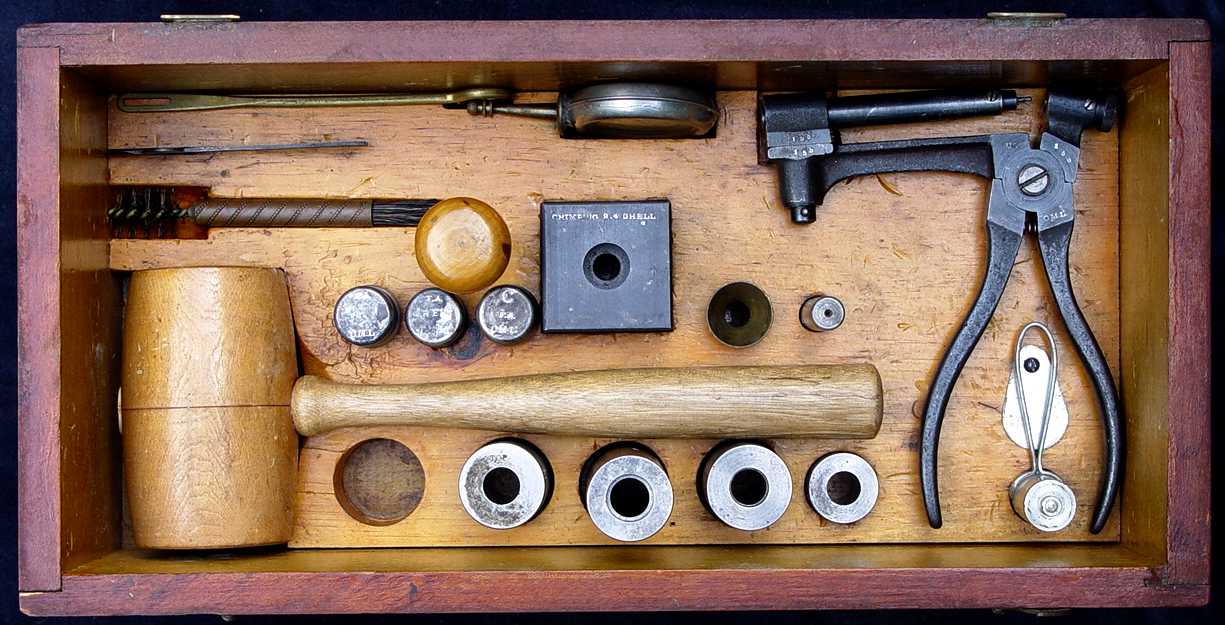
Here's a seldom encountered item, a complete reloading set for the .45
caliber cartridges that were being used by the US Army at the time it was
fabricated at the Frankford Arsenal in the late 1880s. These tool sets were
first produced on an experimental basis in conjunction with the Ordnance
Department's developmental work on a re-loadable cartridge case in 1879. At
this time, the US government was overly restrictive in its funding of the
military, to the extent that regulations stipulated that only 10 rounds of
rifle ammunition were allowed per man per month for target practice. so, one
of the primary benefits of a re-loadable cartridge case was that it would
provide a plentiful and (most important) cheap source of ammunition to be
used by the troops. The tool set shown
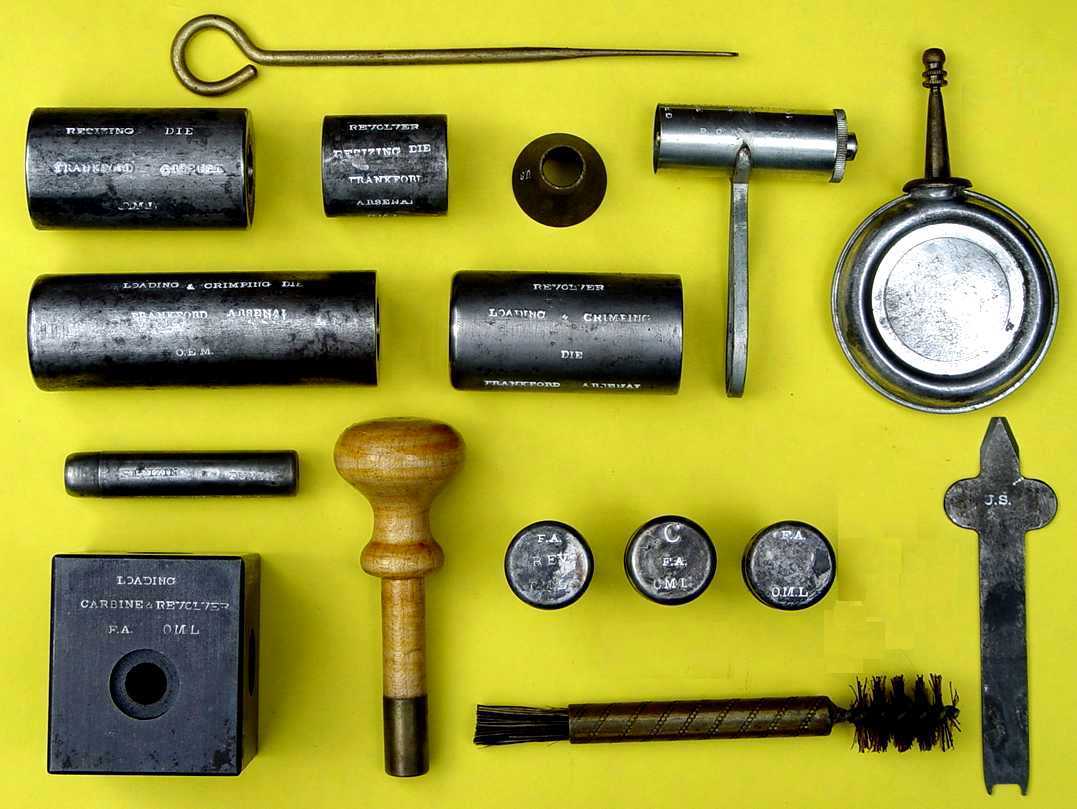 here
is referred to as the Model 1883 set, and was intended for reloading the .45 Colt revolver
cartridge and three different .45 cartridges for the Springfield Trapdoor -
the .45-55 carbine cartridge, and the .45-70 (2.1") and .45-80 (2.4") rifle
cartridges. Similar sets of tools were also made for the .50-70, the 20
gauge 'forager' shotgun shell, and the various 30 caliber rifle cartridges
(.30-40, .30-03, and .30-06). It is estimated that only a few hundred of these
sets of 45 caliber tools were manufactured, and very few are found intact
today due to the heavy use and misuse that they tended to be subjected to.
During the years that they were in use, Ordnance Department
records reveal that large numbers of the individual tools were produced to
replace those that here
is referred to as the Model 1883 set, and was intended for reloading the .45 Colt revolver
cartridge and three different .45 cartridges for the Springfield Trapdoor -
the .45-55 carbine cartridge, and the .45-70 (2.1") and .45-80 (2.4") rifle
cartridges. Similar sets of tools were also made for the .50-70, the 20
gauge 'forager' shotgun shell, and the various 30 caliber rifle cartridges
(.30-40, .30-03, and .30-06). It is estimated that only a few hundred of these
sets of 45 caliber tools were manufactured, and very few are found intact
today due to the heavy use and misuse that they tended to be subjected to.
During the years that they were in use, Ordnance Department
records reveal that large numbers of the individual tools were produced to
replace those that
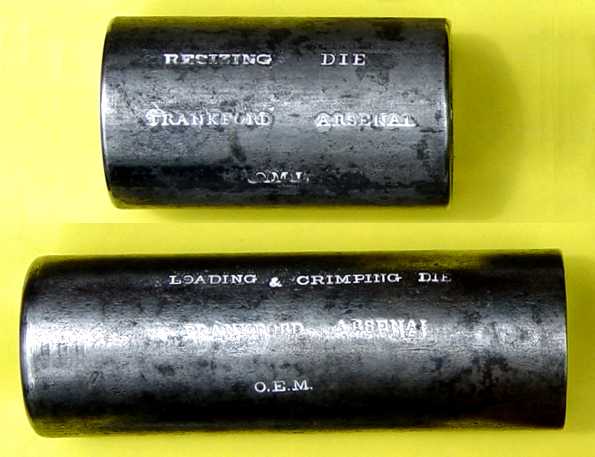 were damaged or misplaced. As a result, very few of the early sets exist today, and those sets that are found tend to have tools
with a mix of inspector's marks, indicating that some of the tools are
replacements. All the tools in this set except the mallet and the priming
tool are shown in the second picture above. Inspector's marks appear on most
of the steel parts. All but one of those were inspected by Major Ormond Mitchell Lissak,
who used the letters 'O.M.L.' as his inspection mark. Major Lissak is
thought to have inspected most of the Model 1883 tool sets, or he inspected
the majority of the replacement tools manufactured for these sets, as his
initials usually appear on the tools in the sets found today. The third
picture above shows the resizing die and the loading and crimping die for
the carbine, rifle and marksman's rifle (2.4") cartridges. The loading and
crimping were damaged or misplaced. As a result, very few of the early sets exist today, and those sets that are found tend to have tools
with a mix of inspector's marks, indicating that some of the tools are
replacements. All the tools in this set except the mallet and the priming
tool are shown in the second picture above. Inspector's marks appear on most
of the steel parts. All but one of those were inspected by Major Ormond Mitchell Lissak,
who used the letters 'O.M.L.' as his inspection mark. Major Lissak is
thought to have inspected most of the Model 1883 tool sets, or he inspected
the majority of the replacement tools manufactured for these sets, as his
initials usually appear on the tools in the sets found today. The third
picture above shows the resizing die and the loading and crimping die for
the carbine, rifle and marksman's rifle (2.4") cartridges. The loading and
crimping
 die
is the one inspected tool in this set that does not bear Major Lissak's
mark. It is marked 'O.E.M.', indicating it was inspected by
Captain Otho Ernest Michaelis. He apparently was a creative sort, as he was issued an 1883
patent on the adjustable powder and shot measure, the silver dipper-looking
object on the upper right side of the picture up above. The fourth picture
above shows the sizing die and the loading and die
is the one inspected tool in this set that does not bear Major Lissak's
mark. It is marked 'O.E.M.', indicating it was inspected by
Captain Otho Ernest Michaelis. He apparently was a creative sort, as he was issued an 1883
patent on the adjustable powder and shot measure, the silver dipper-looking
object on the upper right side of the picture up above. The fourth picture
above shows the sizing die and the loading and
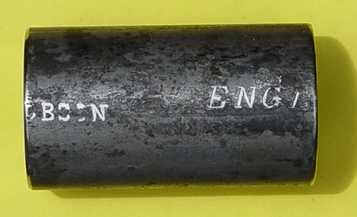 crimping
die for the revolver cartridge. These dies were manufactured at the
arsenal from round steel rod that was imported from Sheffield, England. The
rod was cut to length, drilled and finished inside and on the ends. Other
than the stamped markings, the sides of the dies were not finished, as is
apparent on the rifle resizing die, shown in this fifth picture, which still
has a portion of the name of the foundry (?BSIN?) that produced the
steel, and the letters 'ENGL' indicating the country of origin (England).
The sixth picture shows the markings on the reloading punches used with the
loading crimping
die for the revolver cartridge. These dies were manufactured at the
arsenal from round steel rod that was imported from Sheffield, England. The
rod was cut to length, drilled and finished inside and on the ends. Other
than the stamped markings, the sides of the dies were not finished, as is
apparent on the rifle resizing die, shown in this fifth picture, which still
has a portion of the name of the foundry (?BSIN?) that produced the
steel, and the letters 'ENGL' indicating the country of origin (England).
The sixth picture shows the markings on the reloading punches used with the
loading
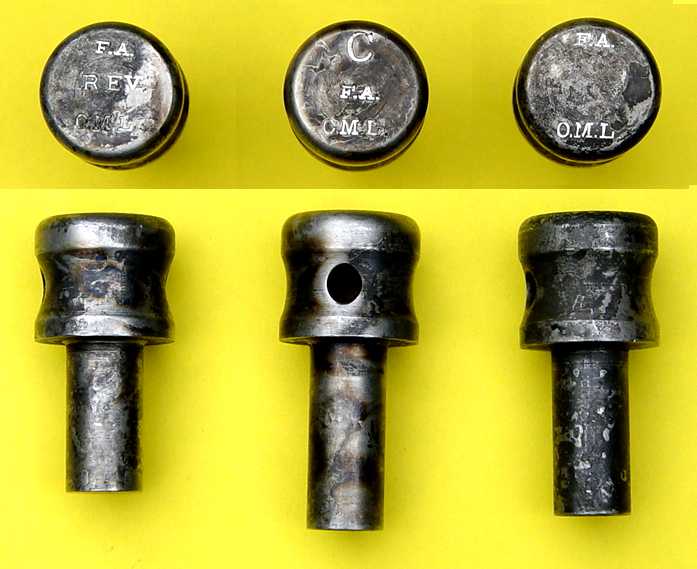 and
crimping dies to seat the bullets to the proper depth. From the left, these
are for the revolver (marked REV), carbine (marked C), and rifle cartridges.
All three have Major Lissak's inspection mark. The punches for the revolver
and carbine show little use, still possessing much of their original
case colors. The last picture shows the six sides of the combination anvil,
a tool which in 1883 replaced the 'safety socket' that is mentioned in the
reloading instructions on most of the old Frankford Arsenal boxes of reloadable ammunition. Each of
the sides serves a specific purpose in the loading process for one or more
of the
different cartridges. and
crimping dies to seat the bullets to the proper depth. From the left, these
are for the revolver (marked REV), carbine (marked C), and rifle cartridges.
All three have Major Lissak's inspection mark. The punches for the revolver
and carbine show little use, still possessing much of their original
case colors. The last picture shows the six sides of the combination anvil,
a tool which in 1883 replaced the 'safety socket' that is mentioned in the
reloading instructions on most of the old Frankford Arsenal boxes of reloadable ammunition. Each of
the sides serves a specific purpose in the loading process for one or more
of the
different cartridges.

.
.
.
.
.
.
.
.
.
.
A tin of Frankford Arsenal primers....

It seems appropriate that I include a tin of the primers that might have
been used with the reloading tools pictured above. This 500 count tin of
primers was made at the Frankford Arsenal in 1901, and is intended for use
with all .45 caliber, .30 caliber gallery, and shotgun black powder
ammunition. The primers fit into holes in round pieces of cardboard, ten of
which are stacked in the tin, with a piece of cloth between each layer. The
patent for this primer was issued on October 14th, 1879 to Jabez H. Gill.
This is the primer that Frankford Arsenal used as they made the change from
the Benet inside-primed cartridge to the
 externally primed
cartridge, which was put into production beginning in August of 1882.
Several views of this primer are shown in this picture, including the
disassembled primer cup and anvil. I've also included Gill's
patent drawing and specifications, as taken from the U.S.Patent Office web
page at
http://www.uspto.gov/patft/index.html . externally primed
cartridge, which was put into production beginning in August of 1882.
Several views of this primer are shown in this picture, including the
disassembled primer cup and anvil. I've also included Gill's
patent drawing and specifications, as taken from the U.S.Patent Office web
page at
http://www.uspto.gov/patft/index.html .
.

.
.
.
.
.
.
.
.
.
.
.
.
.
.
.
.
.
.
.
.
.
.
.
.
.
.

.
.
.
.
.
.
.
.
.
.
.
.
.
.
.
.
.
.
.
A box of .45-80-500 long range
cartridges......

.
.
.
.
.
.
.
Here's a box of .45-80-500 long range rifle cartridges, made at the
Frankford Arsenal on June 13, 1883. This is the cartridge with the 2.4"
shell that could be reloaded with the tool set shown above; these are
headstamped R 6 F 83. Note the reloading instructions on
the front of the box. This cartridge was 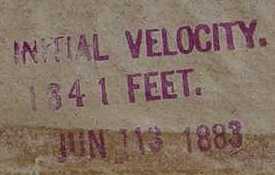 produced
over a five year period, from April of 1880 through April of 1884, for use
with a rifle being experimented with at the Springfield Armory. In addition
to having 10 more grains of powder than the standard .45-70 cartridge, the
long range cartridge had a 500 grain bullet, compared with the standard 405
grain bullet. The results of the tests in 1881 revealed that the cartridge
was more accurate, but that it was the heavier bullet that was responsible
for the accuracy, and not the heavier powder load. As a result, the 500
grain bullet was adopted in January of 1882 as the standard for rifle
cartridges, the 405 grain bullet being retained for use with the carbine. produced
over a five year period, from April of 1880 through April of 1884, for use
with a rifle being experimented with at the Springfield Armory. In addition
to having 10 more grains of powder than the standard .45-70 cartridge, the
long range cartridge had a 500 grain bullet, compared with the standard 405
grain bullet. The results of the tests in 1881 revealed that the cartridge
was more accurate, but that it was the heavier bullet that was responsible
for the accuracy, and not the heavier powder load. As a result, the 500
grain bullet was adopted in January of 1882 as the standard for rifle
cartridges, the 405 grain bullet being retained for use with the carbine.

.
.
|


 here
is referred to as the Model 1883 set, and was intended for reloading the .45 Colt revolver
cartridge and three different .45 cartridges for the Springfield Trapdoor -
the .45-55 carbine cartridge, and the .45-70 (2.1") and .45-80 (2.4") rifle
cartridges. Similar sets of tools were also made for the .50-70, the 20
gauge 'forager' shotgun shell, and the various 30 caliber rifle cartridges
(.30-40, .30-03, and .30-06). It is estimated that only a few hundred of these
sets of 45 caliber tools were manufactured, and very few are found intact
today due to the heavy use and misuse that they tended to be subjected to.
During the years that they were in use, Ordnance Department
records reveal that large numbers of the individual tools were produced to
replace those that
here
is referred to as the Model 1883 set, and was intended for reloading the .45 Colt revolver
cartridge and three different .45 cartridges for the Springfield Trapdoor -
the .45-55 carbine cartridge, and the .45-70 (2.1") and .45-80 (2.4") rifle
cartridges. Similar sets of tools were also made for the .50-70, the 20
gauge 'forager' shotgun shell, and the various 30 caliber rifle cartridges
(.30-40, .30-03, and .30-06). It is estimated that only a few hundred of these
sets of 45 caliber tools were manufactured, and very few are found intact
today due to the heavy use and misuse that they tended to be subjected to.
During the years that they were in use, Ordnance Department
records reveal that large numbers of the individual tools were produced to
replace those that
 were damaged or misplaced. As a result, very few of the early sets exist today, and those sets that are found tend to have tools
with a mix of inspector's marks, indicating that some of the tools are
replacements. All the tools in this set except the mallet and the priming
tool are shown in the second picture above. Inspector's marks appear on most
of the steel parts. All but one of those were inspected by Major Ormond Mitchell Lissak,
who used the letters 'O.M.L.' as his inspection mark. Major Lissak is
thought to have inspected most of the Model 1883 tool sets, or he inspected
the majority of the replacement tools manufactured for these sets, as his
initials usually appear on the tools in the sets found today. The third
picture above shows the resizing die and the loading and crimping die for
the carbine, rifle and marksman's rifle (2.4") cartridges. The loading and
crimping
were damaged or misplaced. As a result, very few of the early sets exist today, and those sets that are found tend to have tools
with a mix of inspector's marks, indicating that some of the tools are
replacements. All the tools in this set except the mallet and the priming
tool are shown in the second picture above. Inspector's marks appear on most
of the steel parts. All but one of those were inspected by Major Ormond Mitchell Lissak,
who used the letters 'O.M.L.' as his inspection mark. Major Lissak is
thought to have inspected most of the Model 1883 tool sets, or he inspected
the majority of the replacement tools manufactured for these sets, as his
initials usually appear on the tools in the sets found today. The third
picture above shows the resizing die and the loading and crimping die for
the carbine, rifle and marksman's rifle (2.4") cartridges. The loading and
crimping
 die
is the one inspected tool in this set that does not bear Major Lissak's
mark. It is marked 'O.E.M.', indicating it was inspected by
Captain Otho Ernest Michaelis. He apparently was a creative sort, as he was issued an 1883
patent on the adjustable powder and shot measure, the silver dipper-looking
object on the upper right side of the picture up above. The fourth picture
above shows the sizing die and the loading and
die
is the one inspected tool in this set that does not bear Major Lissak's
mark. It is marked 'O.E.M.', indicating it was inspected by
Captain Otho Ernest Michaelis. He apparently was a creative sort, as he was issued an 1883
patent on the adjustable powder and shot measure, the silver dipper-looking
object on the upper right side of the picture up above. The fourth picture
above shows the sizing die and the loading and
 crimping
die for the revolver cartridge. These dies were manufactured at the
arsenal from round steel rod that was imported from Sheffield, England. The
rod was cut to length, drilled and finished inside and on the ends. Other
than the stamped markings, the sides of the dies were not finished, as is
apparent on the rifle resizing die, shown in this fifth picture, which still
has a portion of the name of the foundry (?BSIN?) that produced the
steel, and the letters 'ENGL' indicating the country of origin (England).
The sixth picture shows the markings on the reloading punches used with the
loading
crimping
die for the revolver cartridge. These dies were manufactured at the
arsenal from round steel rod that was imported from Sheffield, England. The
rod was cut to length, drilled and finished inside and on the ends. Other
than the stamped markings, the sides of the dies were not finished, as is
apparent on the rifle resizing die, shown in this fifth picture, which still
has a portion of the name of the foundry (?BSIN?) that produced the
steel, and the letters 'ENGL' indicating the country of origin (England).
The sixth picture shows the markings on the reloading punches used with the
loading
 and
crimping dies to seat the bullets to the proper depth. From the left, these
are for the revolver (marked REV), carbine (marked C), and rifle cartridges.
All three have Major Lissak's inspection mark. The punches for the revolver
and carbine show little use, still possessing much of their original
case colors. The last picture shows the six sides of the combination anvil,
a tool which in 1883 replaced the 'safety socket' that is mentioned in the
reloading instructions on most of the old Frankford Arsenal boxes of reloadable ammunition. Each of
the sides serves a specific purpose in the loading process for one or more
of the
different cartridges.
and
crimping dies to seat the bullets to the proper depth. From the left, these
are for the revolver (marked REV), carbine (marked C), and rifle cartridges.
All three have Major Lissak's inspection mark. The punches for the revolver
and carbine show little use, still possessing much of their original
case colors. The last picture shows the six sides of the combination anvil,
a tool which in 1883 replaced the 'safety socket' that is mentioned in the
reloading instructions on most of the old Frankford Arsenal boxes of reloadable ammunition. Each of
the sides serves a specific purpose in the loading process for one or more
of the
different cartridges.


 externally primed
cartridge, which was put into production beginning in August of 1882.
Several views of this primer are shown in this picture, including the
disassembled primer cup and anvil. I've also included Gill's
patent drawing and specifications, as taken from the U.S.Patent Office web
page at
externally primed
cartridge, which was put into production beginning in August of 1882.
Several views of this primer are shown in this picture, including the
disassembled primer cup and anvil. I've also included Gill's
patent drawing and specifications, as taken from the U.S.Patent Office web
page at



 produced
over a five year period, from April of 1880 through April of 1884, for use
with a rifle being experimented with at the Springfield Armory. In addition
to having 10 more grains of powder than the standard .45-70 cartridge, the
long range cartridge had a 500 grain bullet, compared with the standard 405
grain bullet. The results of the tests in 1881 revealed that the cartridge
was more accurate, but that it was the heavier bullet that was responsible
for the accuracy, and not the heavier powder load. As a result, the 500
grain bullet was adopted in January of 1882 as the standard for rifle
cartridges, the 405 grain bullet being retained for use with the carbine.
produced
over a five year period, from April of 1880 through April of 1884, for use
with a rifle being experimented with at the Springfield Armory. In addition
to having 10 more grains of powder than the standard .45-70 cartridge, the
long range cartridge had a 500 grain bullet, compared with the standard 405
grain bullet. The results of the tests in 1881 revealed that the cartridge
was more accurate, but that it was the heavier bullet that was responsible
for the accuracy, and not the heavier powder load. As a result, the 500
grain bullet was adopted in January of 1882 as the standard for rifle
cartridges, the 405 grain bullet being retained for use with the carbine. 